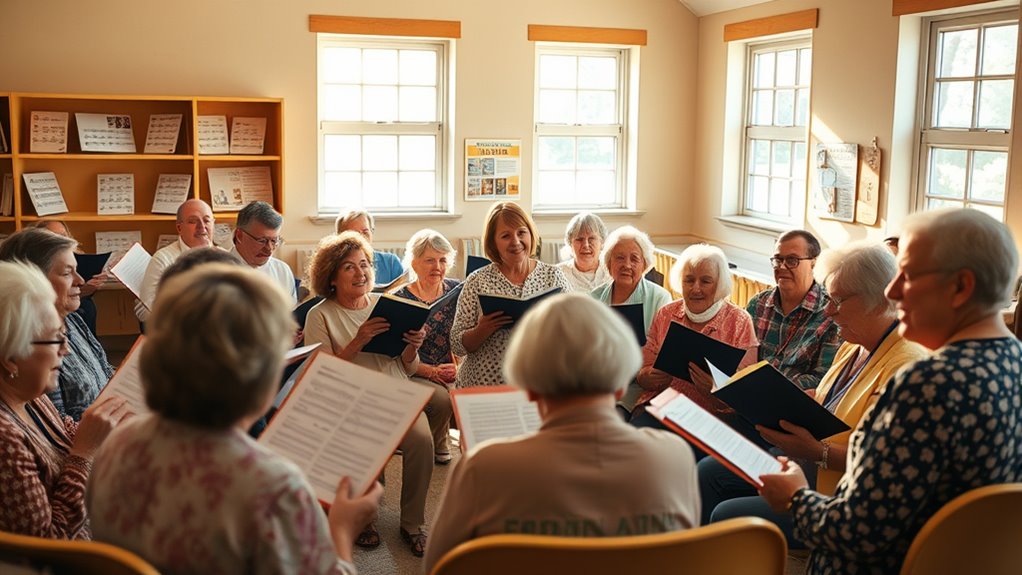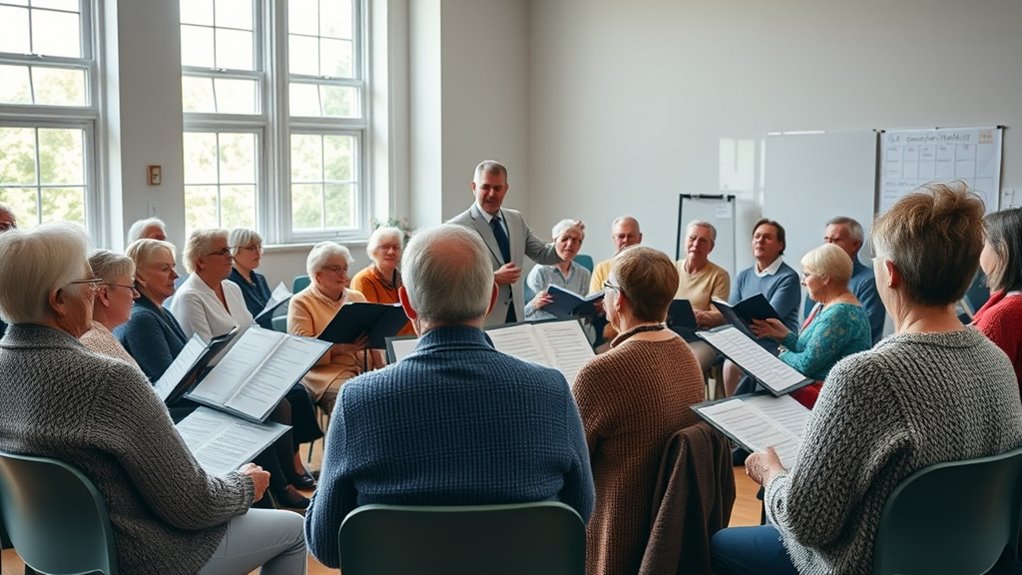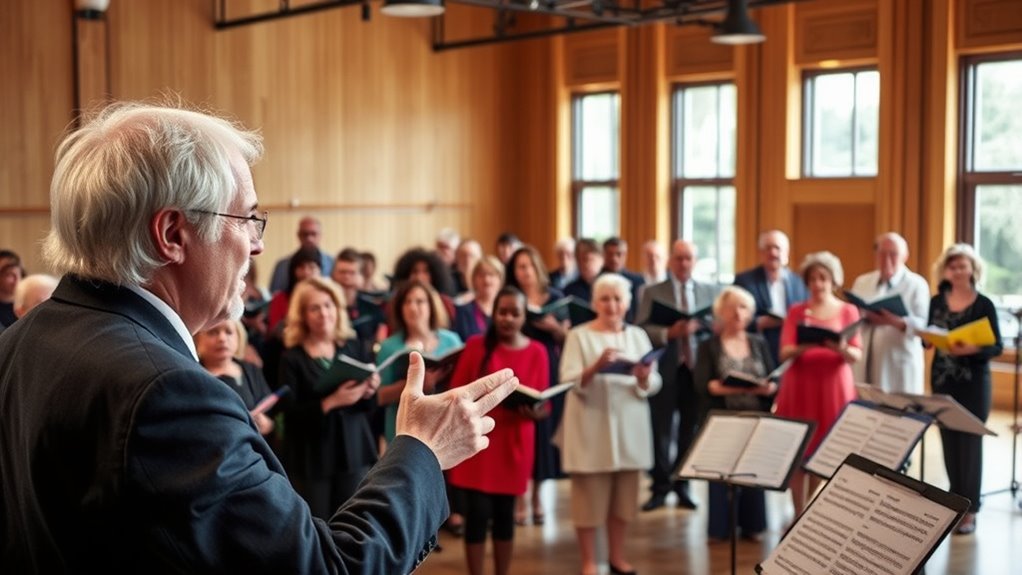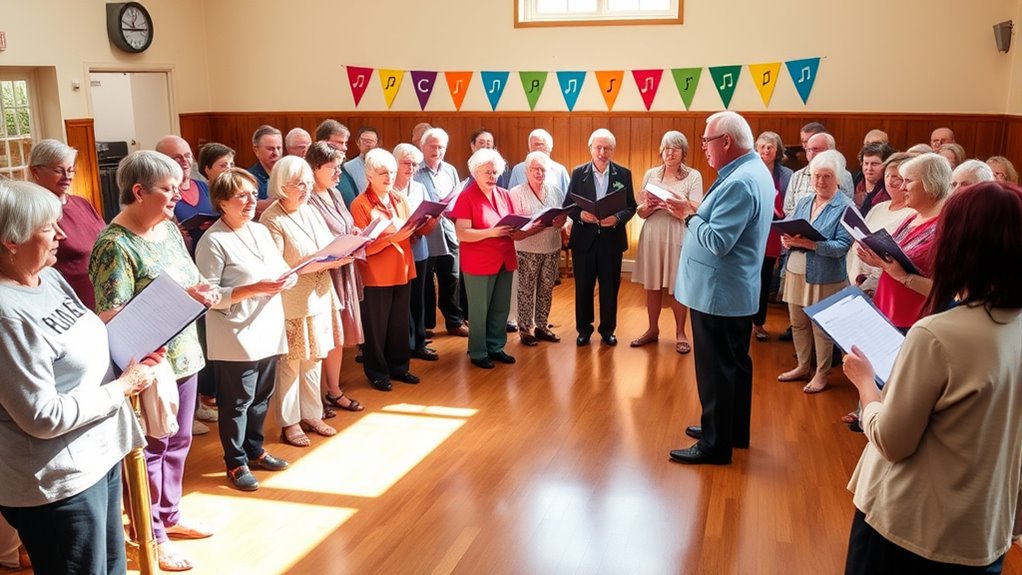To create a senior choir, start by engaging your community to gauge interest and set clear, achievable goals. Secure accessible venues for rehearsals and performances, ensuring inclusivity for all members. Recruit participants through promotions and foster a supportive atmosphere with regular rehearsals focused on suitable, familiar songs. Organize the logistics, including schedules and performance plans, while emphasizing encouragement and camaraderie. Keep discovering these steps to build a vibrant, engaging choir that promotes connection and joy.
Key Takeaways
- Assess community interest, set goals, and build partnerships with local venues and organizations.
- Secure accessible, comfortable rehearsal spaces with proper acoustic and inclusive features.
- Recruit members through targeted promotion and ongoing community engagement initiatives.
- Choose suitable, familiar, and uplifting repertoire tailored to senior voices and diverse genres.
- Foster an inclusive, organized environment with structured rehearsals, health considerations, and motivational support.
Assessing Community Interest and Setting Goals

Before launching a senior choir, you need to gauge whether there’s genuine interest in your community. Talk to local senior centers, community groups, and potential members to assess their enthusiasm. Consider how music therapy benefits seniors by enhancing mood and memory, making your choir more appealing. Look into historical choir models to understand successful structures and repertoire choices that resonate with seniors. Conduct surveys or informal conversations to identify preferred genres and schedules. Setting clear goals based on this feedback helps ensure your choir serves its members’ needs and interests. Building a strong foundation by understanding what motivates seniors to join and participate will increase your chances of creating a vibrant, sustainable choir. Additionally, exploring successful choir models can provide insights into effective organization and engagement strategies. Your enthusiasm and research are key to turning this idea into a thriving community activity.
Securing a Suitable Venue for Rehearsals and Performances

Once you’ve assessed community interest and set clear goals for your senior choir, securing a suitable venue becomes the next essential step. You need a space that’s accessible, comfortable, and adaptable. Consider the venue’s acoustics—proper acoustic treatment minimizes echo and ensures everyone can hear clearly. Lighting design is equally important, creating a warm, inviting atmosphere for rehearsals and performances. Here’s a quick visualization:
| Venue Features | Benefits |
|---|---|
| Acoustic treatment | Clear sound, better choir cohesion |
| Lighting design | Enhances mood, visibility |
| Accessibility | Easy for seniors to reach |
| Space size | Enough room for movement and sound |
Choosing the right venue sets the foundation for your choir’s success. Incorporating AI-driven acoustic design can further optimize sound quality for your space.
Recruiting Members and Promoting the Choir

To build a vibrant senior choir, start by actively reaching out to your community through flyers, social media, and local events to attract interested members. Engaging your audience is key—share inspiring stories about the choir’s purpose to foster interest and commitment. Use clear calls to action, encouraging seniors to join or attend an introductory event. Promote the choir consistently to maintain visibility and excitement. Additionally, explore fundraising strategies to support your activities and outreach efforts, such as sponsorships, donations, or bake sales. These efforts not only boost your choir’s profile but also help sustain its growth. By focusing on audience engagement and strategic promotion, you’ll create a welcoming environment that inspires seniors to join and participate actively. Incorporating community engagement strategies can significantly enhance your choir’s outreach and success.
Selecting Appropriate Repertoire for Senior Voices

Choosing the right repertoire is essential for ensuring your senior choir remains engaging and enjoyable for all members. Focus on repertoire selection that suits their vocal techniques, emphasizing melody and harmony that aren’t overly demanding. Select pieces with familiar themes or uplifting messages to boost confidence and enjoyment. Incorporate a variety of genres to keep rehearsals fresh and interesting. Use this table to guide your choices:
| Genre | Characteristics |
|---|---|
| Folk & Traditional | Simple melodies, easy vocal ranges |
| Sacred & Classical | Rich harmonies, accessible for all voices |
| Popular & Contemporary | Catchy tunes, moderate vocal demands |
Additionally, understanding relationship dynamics can help foster a more supportive and harmonious choir environment.
Planning Rehearsal Schedules and Session Structure

Effective rehearsal planning involves creating a consistent schedule that balances practice time with rest and social interaction. Begin each session with vocal warm-ups to loosen singers’ voices and prepare them for focused work. Incorporate exercises that include chord progressions to help singers develop their ear and improve pitch accuracy. Structure your rehearsals into segments: warm-ups, technical work, and song practice. Keep sessions engaging by varying activities and allowing short breaks to prevent fatigue. Be mindful of senior singers’ stamina, and avoid lengthy sessions. Plan ahead to ensure each rehearsal builds on the previous one, reinforcing skills and confidence. Including structured segments helps keep the rehearsal flow organized and productive. A well-structured schedule keeps rehearsals productive, enjoyable, and respectful of everyone’s time and energy.
Choosing Conductors and Choir Leaders

Selecting the right conductors and choir leaders is essential for guiding your senior choir toward success. Look for individuals passionate about working with seniors and who understand the importance of a welcoming, encouraging environment. They should be comfortable with choir attire that enhances camaraderie and confidence, creating a unified appearance. When choosing leaders, consider their ability to coordinate musical instrumentation, ensuring arrangements are appropriate for the choir’s skill level. Strong conductors inspire members, help develop vocal techniques, and foster a sense of teamwork. Their leadership shapes rehearsals and performances, making the choir more cohesive and spirited. Additionally, understanding home essentials can help in creating a comfortable environment for rehearsals and performances. Ultimately, effective conductors and leaders will motivate your seniors, promote enjoyment, and elevate the overall quality of your choir’s performances.
Organizing Administrative Tasks and Membership Records

Organizing administrative tasks and maintaining accurate membership records are essential steps in running a smooth senior choir. You’ll want a clear system for tracking member contact information, attendance, and dues. This helps guarantee effective communication and keeps everyone engaged. Keep your music repertoire organized, so you can easily select pieces and distribute sheet music. Regularly plan vocal warm ups, and record attendance to monitor participation. Using spreadsheets or choir management software simplifies updates and helps prevent confusion. Assign someone to oversee these administrative duties, so responsibilities stay manageable. Accurate records also support planning future performances and community events. Additionally, understanding expiration dates on supplies and materials can help ensure the safety and quality of your choir’s resources. Overall, a well-organized administrative system enables you to focus more on rehearsals, fostering a positive choir environment. Staying organized keeps your senior choir thriving and enjoyable for everyone involved.
Preparing for Performances and Community Engagement

You’ll want to set up rehearsal schedules that fit everyone’s availability, so your choir stays well-prepared. Connecting with local organizations and event planners can help you find opportunities to showcase your choir’s talents. By fostering these community relationships, you’ll create meaningful performances that resonate with your audience. Incorporating auditory processing techniques into your rehearsals can also enhance members’ listening and singing coordination.
Organizing Rehearsal Schedules
To guarantee your senior choir is well-prepared for upcoming performances and community events, establishing a clear and consistent rehearsal schedule is essential. Begin each session with vocal warm ups to help singers loosen their voices and prevent strain. Incorporate choir etiquette by encouraging punctuality, attentive listening, and respectful interaction, creating a positive rehearsal environment. Set specific goals for each rehearsal to ensure steady progress and avoid last-minute stress. Keep the schedule realistic to accommodate members’ other commitments, and communicate it well in advance. Regularly review progress and adjust the schedule as needed to maintain momentum. Using headphones during rehearsals can help singers focus and monitor their pitch individually. A well-organized plan keeps rehearsals productive, builds confidence, and ensures everyone is ready for performances.
Building Community Connections
Building strong community connections enhances your senior choir’s impact beyond rehearsals. To prepare for performances and community engagement, focus on fostering relationships with local groups and venues. Incorporate harmonizing techniques into your rehearsals to boost confidence and cohesion, making performances more engaging. Prior to singing, lead your choir through vocal warm ups to ensure everyone’s voice is prepared and healthy. Engage with the community by organizing open rehearsals or mini-performances at local events, which helps build awareness and support. Collaborate with community centers, churches, or senior centers to create opportunities for shared performances. These connections not only amplify your choir’s presence but also deepen members’ sense of belonging and purpose. Building community connections can also help your choir access resources and support from local organizations. Strong community ties make your choir’s journey more meaningful and impactful.
Ensuring Accessibility and Inclusivity Within the Choir

To make your choir truly accessible, consider using adaptive seating arrangements that accommodate different mobility needs. You should also implement inclusive communication strategies, like clear language and visual cues, to guarantee everyone feels involved. By prioritizing these approaches, you create a welcoming environment where all seniors can participate comfortably.
Adaptive Seating Arrangements
Ensuring accessibility and inclusivity within your senior choir begins with thoughtful adaptive seating arrangements. You want every member to feel comfortable and supported, so consider adaptive furniture that accommodates mobility aids or provides extra lumbar support. Arrange seats to allow easy access and clear sightlines for all. Incorporate sensory integration by adding textured cushions or adjustable lighting to create a calming environment. Keep pathways wide enough for wheelchairs or walkers, and avoid clutter that could cause tripping. Flexibility is key—allow members to choose seats that suit their needs. By intentionally designing your seating plan, you foster a welcoming atmosphere that encourages participation and confidence.
- Use adjustable chairs for personalized comfort
- Place sensory-friendly objects nearby
- Ensure wide, unobstructed aisles
- Incorporate supportive cushions or backrests
- Arrange seats in circles or semi-circles for better interaction
Inclusive Communication Strategies
Creating an inclusive environment in your senior choir relies heavily on effective communication strategies that respect diverse needs. Incorporate sign language into your rehearsals to support members with hearing impairments. Training or partnering with sign language interpreters can make lyrics and instructions accessible. Additionally, use visual cues like hand signals, pictures, or written prompts to reinforce musical cues and directions. These cues help members who process information visually or have difficulty hearing. Keep your communication clear, simple, and consistent. Encourage members to share their needs and preferences, fostering an atmosphere of openness. By integrating sign language and visual cues, you create a welcoming space where every member feels understood and valued, enhancing overall inclusivity and making your choir truly accessible for all.
Maintaining Motivation and Fostering a Supportive Environment

Maintaining motivation within a senior choir requires intentional efforts to keep members engaged and inspired. To foster a supportive environment, focus on creating opportunities for intergenerational bonding, which can boost morale and enrich the experience. Incorporate musical therapy techniques to support mental well-being and keep rehearsals lively. Celebrate milestones and progress to boost confidence. Encourage members to share stories behind songs, building personal connections. Use positive reinforcement to acknowledge everyone’s contributions. Keep rehearsals fun and varied, mixing familiar pieces with new challenges. Promote a sense of community where everyone feels valued. Remember, a motivated choir thrives on camaraderie, encouragement, and meaningful interactions that strengthen bonds and sustain enthusiasm.
Frequently Asked Questions
How Can I Secure Funding or Sponsorship for the Choir?
To secure funding or sponsorship for your choir, explore grant opportunities from local arts councils or community foundations that support music programs. Use sponsorship strategies like approaching local businesses, offering recognition in concerts or programs in exchange for support. Reach out with a compelling proposal highlighting your choir’s benefits and community impact. Building relationships and demonstrating the value your choir brings will increase your chances of obtaining sponsorship or grants.
What Are Best Practices for Recruiting Diverse Senior Members?
Imagine your choir as a vibrant tapestry, each thread representing a different background. To recruit diverse senior members, embrace cultural inclusion and reach out through community outreach. Attend local events, partner with cultural organizations, and guarantee your messaging celebrates diversity. By creating an inviting atmosphere, you’ll attract a rich mix of voices, making your choir a true reflection of the community’s beautiful mosaic.
How Do I Handle Health and Mobility Issues Among Members?
To handle health and mobility issues among members, focus on adaptive seating and choosing accessible venues. You can arrange chairs with armrests or cushions for comfort and stability. Make certain your rehearsals are held in locations with ramps or elevators, making it easier for everyone to participate. Regularly check in with members about their needs, and be flexible with seating arrangements to promote an inclusive, supportive environment for all seniors.
What Legal Considerations Are Involved in Forming a Senior Choir?
When forming a senior choir, you need to take into account legal aspects like music licensing to avoid copyright infringement. Additionally, securing liability insurance protects you and your members from potential accidents or injuries during rehearsals and performances. Make sure to review local regulations and possibly consult a legal expert to ensure compliance. These steps help you create a safe, legal environment for everyone involved, giving you peace of mind.
How Can Technology Be Integrated Into Choir Rehearsals and Performances?
Imagine a conductor guiding a wave of light, each beam representing your choir’s harmony. You can integrate technology by using digital sheet music, making it easy for members to access and follow along. Online rehearsal tools act like a bridge, connecting voices from afar and enhancing practice sessions. This fusion of tech and tradition helps your choir perform with precision, unity, and a modern touch that inspires everyone involved.
Conclusion
Starting a senior choir is a rewarding journey that boosts community spirit and individual well-being. Did you know singing can improve memory and reduce stress? By following these steps, you create not just a choir, but a supportive, inclusive space where seniors can thrive. Embrace the process, stay flexible, and watch how music brings joy and connection—proving that age truly is just a number when it comes to making beautiful harmony together.









